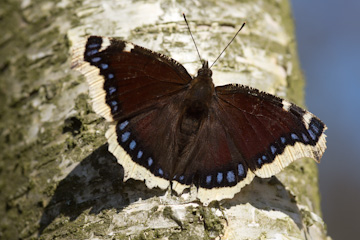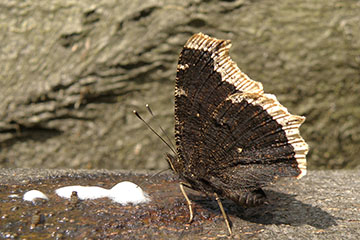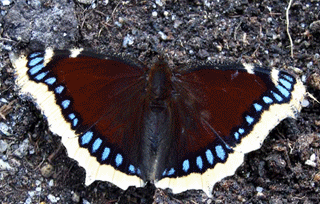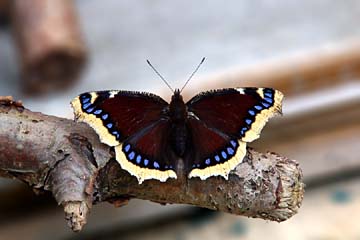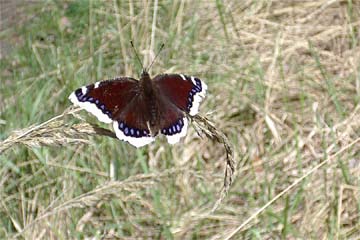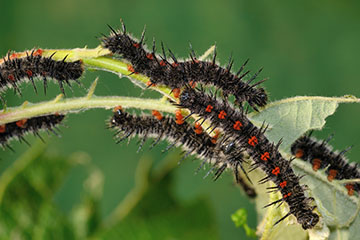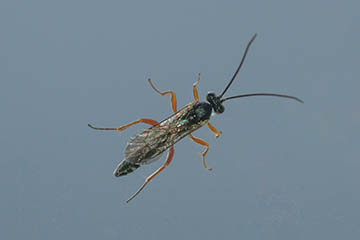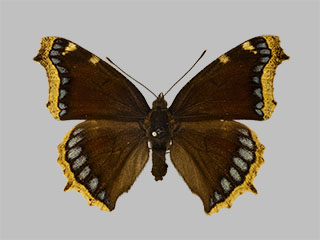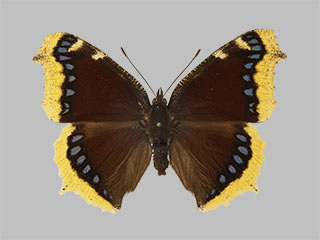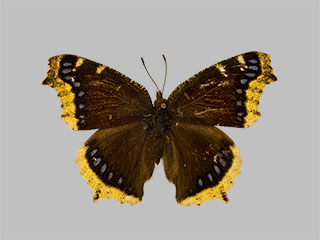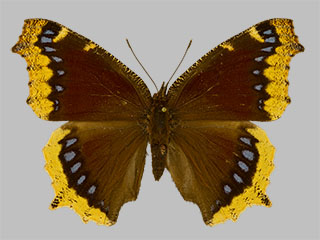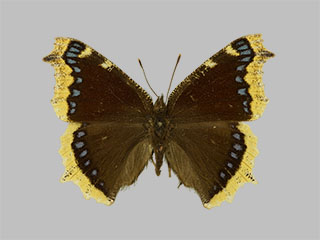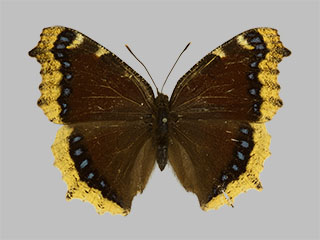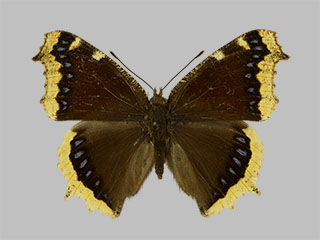You have seen a  Camberwell BeautyNymphalis antiopa (Linnaeus, 1758)Mourning CloakCamberwell Beauty? Have you become interested in this beautiful, rare and shy butterfly?
Camberwell BeautyNymphalis antiopa (Linnaeus, 1758)Mourning CloakCamberwell Beauty? Have you become interested in this beautiful, rare and shy butterfly?
Welcome to Trauermantel.de!
At Trauermantel.de you will find everything you need to know about the  Camberwell BeautyNymphalis antiopa (Linnaeus, 1758)Mourning CloakCamberwell Beauty.
Camberwell BeautyNymphalis antiopa (Linnaeus, 1758)Mourning CloakCamberwell Beauty.
A colourful summer meadow is not one of its favourite places, even though the  Camberwell BeautyNymphalis antiopa (Linnaeus, 1758)Mourning CloakCamberwell Beauty may cross many a meadow on its flights.
Camberwell BeautyNymphalis antiopa (Linnaeus, 1758)Mourning CloakCamberwell Beauty may cross many a meadow on its flights.
That's because the  Camberwell BeautyNymphalis antiopa (Linnaeus, 1758)Mourning CloakCamberwell Beauty is not addicted to flowers and their nectar. He prefers savory food: The droppings and sweat of some animals, including fully mature fruits. And it especially likes the sap from trees.
Camberwell BeautyNymphalis antiopa (Linnaeus, 1758)Mourning CloakCamberwell Beauty is not addicted to flowers and their nectar. He prefers savory food: The droppings and sweat of some animals, including fully mature fruits. And it especially likes the sap from trees.
Find out more here: Behaviour (Butterfly Food).
Usually adult butterflies have six legs. The  Camberwell BeautyNymphalis antiopa (Linnaeus, 1758)Mourning CloakCamberwell Beauty has only four. The front pair of legs has evolved into cleaning paws. This characteristic is typical to all species of the Brush-footed ButterflyNymphalidaeFour-footed ButterflyBrush-footed Butterflies family.
Camberwell BeautyNymphalis antiopa (Linnaeus, 1758)Mourning CloakCamberwell Beauty has only four. The front pair of legs has evolved into cleaning paws. This characteristic is typical to all species of the Brush-footed ButterflyNymphalidaeFour-footed ButterflyBrush-footed Butterflies family.
Find out more here: Appearance as Imago (Body).
The closest relative of the  Camberwell BeautyNymphalis antiopa (Linnaeus, 1758)Mourning CloakCamberwell Beauty doesn't look similar at first sight: The
Camberwell BeautyNymphalis antiopa (Linnaeus, 1758)Mourning CloakCamberwell Beauty doesn't look similar at first sight: The  Large TortoiseshellNymphalis polychloros (Linnaeus, 1758)Large Tortoiseshell.
Large TortoiseshellNymphalis polychloros (Linnaeus, 1758)Large Tortoiseshell.
Find out more here: Systematics (Phylogeny).
The appearance of the  Camberwell BeautyNymphalis antiopa (Linnaeus, 1758)Mourning CloakCamberwell Beauty's is unique and inimitable worldwide!
Camberwell BeautyNymphalis antiopa (Linnaeus, 1758)Mourning CloakCamberwell Beauty's is unique and inimitable worldwide!
Find out more here: Appearance as Imago.
And the  Camberwell BeautyNymphalis antiopa (Linnaeus, 1758)Mourning CloakCamberwell Beauty can grow old! Even very old for a butterfly: A year and sometimes actually some more.
Camberwell BeautyNymphalis antiopa (Linnaeus, 1758)Mourning CloakCamberwell Beauty can grow old! Even very old for a butterfly: A year and sometimes actually some more.
Find out more here: Development (Imago Stage).
During its long lifetime, the  Camberwell BeautyNymphalis antiopa (Linnaeus, 1758)Mourning CloakCamberwell Beauty is exposed to many dangers: These include predators, lack of food, but also too much cold or too much heat. Therefore the
Camberwell BeautyNymphalis antiopa (Linnaeus, 1758)Mourning CloakCamberwell Beauty is exposed to many dangers: These include predators, lack of food, but also too much cold or too much heat. Therefore the  Camberwell BeautyNymphalis antiopa (Linnaeus, 1758)Mourning CloakCamberwell Beauty performs two longer rest periods: One in summer and one in winter.
Camberwell BeautyNymphalis antiopa (Linnaeus, 1758)Mourning CloakCamberwell Beauty performs two longer rest periods: One in summer and one in winter.
Find out more here: Behaviour (Aestivation) Behaviour (Hibernation).
In winter the  Camberwell BeautyNymphalis antiopa (Linnaeus, 1758)Mourning CloakCamberwell Beauty mostly loses the yellow colour of it's wing edges. Comparable to people losing the colour of their head hair as they get old. As a result, the
Camberwell BeautyNymphalis antiopa (Linnaeus, 1758)Mourning CloakCamberwell Beauty mostly loses the yellow colour of it's wing edges. Comparable to people losing the colour of their head hair as they get old. As a result, the  Camberwell BeautyNymphalis antiopa (Linnaeus, 1758)Mourning CloakCamberwell Beauty presents itself in spring with a white border after its hibernation. Until the next generation
Camberwell BeautyNymphalis antiopa (Linnaeus, 1758)Mourning CloakCamberwell Beauty presents itself in spring with a white border after its hibernation. Until the next generation  Camberwell BeautyNymphalis antiopa (Linnaeus, 1758)Mourning CloakCamberwell Beauties with yellow borders appears in summer.
Camberwell BeautyNymphalis antiopa (Linnaeus, 1758)Mourning CloakCamberwell Beauties with yellow borders appears in summer.
Find out more here: Research about border-color (Outline).
Sometimes the  Camberwell BeautyNymphalis antiopa (Linnaeus, 1758)Mourning CloakCamberwell Beauty does not survive its hibernating: Especially when it's too warm. For this reason, it cannot hibernate on the British Isles. Due to man-made climate change, this is also now a problem for the
Camberwell BeautyNymphalis antiopa (Linnaeus, 1758)Mourning CloakCamberwell Beauty does not survive its hibernating: Especially when it's too warm. For this reason, it cannot hibernate on the British Isles. Due to man-made climate change, this is also now a problem for the  Camberwell BeautyNymphalis antiopa (Linnaeus, 1758)Mourning CloakCamberwell Beauty in many other areas.
Camberwell BeautyNymphalis antiopa (Linnaeus, 1758)Mourning CloakCamberwell Beauty in many other areas.
Find out more here: Distribution in United Kingdom.
Nevertheless the British particularly like their  Camberwell BeautyNymphalis antiopa (Linnaeus, 1758)Mourning CloakCamberwell Beauty. They even eternalised its first documented locality in
Camberwell BeautyNymphalis antiopa (Linnaeus, 1758)Mourning CloakCamberwell Beauty. They even eternalised its first documented locality in  England
England England in its British name: Camberwell Beauty
England in its British name: Camberwell Beauty
Find out more here: Honouring (Camberwell/London).
The  Camberwell BeautyNymphalis antiopa (Linnaeus, 1758)Mourning CloakCamberwell Beauty doesn't like to stay in one locality, it drives him far away: It can cross entire countries in fast flight.
Camberwell BeautyNymphalis antiopa (Linnaeus, 1758)Mourning CloakCamberwell Beauty doesn't like to stay in one locality, it drives him far away: It can cross entire countries in fast flight.
Find out more here: Behaviour (Migration).
Being a caterpillar, the  Camberwell BeautyNymphalis antiopa (Linnaeus, 1758)Mourning CloakCamberwell Beauty prefers to feed on WillowSalixWillows and BirchBetulaBirches.
Camberwell BeautyNymphalis antiopa (Linnaeus, 1758)Mourning CloakCamberwell Beauty prefers to feed on WillowSalixWillows and BirchBetulaBirches.
Find out more here: Development (Larval Host Plants).
Furthermore the  Camberwell BeautyNymphalis antiopa (Linnaeus, 1758)Mourning CloakCamberwell Beauty is on the menu of many other animals. The caterpillars often have to combat with Organism that lives in close association with its host at the host's expense, eventually resulting in the death of the hostParasitoids. That's the reason why only very few
Camberwell BeautyNymphalis antiopa (Linnaeus, 1758)Mourning CloakCamberwell Beauty is on the menu of many other animals. The caterpillars often have to combat with Organism that lives in close association with its host at the host's expense, eventually resulting in the death of the hostParasitoids. That's the reason why only very few  Camberwell BeautyNymphalis antiopa (Linnaeus, 1758)Mourning CloakCamberwell Beauties survive the period until leaving the chrysalis.
Camberwell BeautyNymphalis antiopa (Linnaeus, 1758)Mourning CloakCamberwell Beauties survive the period until leaving the chrysalis.
Find out more here: Behaviour (Defence & Enemies).
Sometimes the  Camberwell BeautyNymphalis antiopa (Linnaeus, 1758)Mourning CloakCamberwell Beauty looks very unusual in its adult butterfly stage: When it was extremely cold or extremely warm during its pupal period.
Camberwell BeautyNymphalis antiopa (Linnaeus, 1758)Mourning CloakCamberwell Beauty looks very unusual in its adult butterfly stage: When it was extremely cold or extremely warm during its pupal period.
This fact was recognized around 100 years ago and many varieties of experiments were carried out with the  Camberwell BeautyNymphalis antiopa (Linnaeus, 1758)Mourning CloakCamberwell Beauty.
Camberwell BeautyNymphalis antiopa (Linnaeus, 1758)Mourning CloakCamberwell Beauty.
Find out more here: Forms/Aberrations and Research about temperature effects (Outline).
The  Camberwell BeautyNymphalis antiopa (Linnaeus, 1758)Mourning CloakCamberwell Beauty is widespread in the northern hemisphere of our earth and subclassifies 6 subspecies.
Camberwell BeautyNymphalis antiopa (Linnaeus, 1758)Mourning CloakCamberwell Beauty is widespread in the northern hemisphere of our earth and subclassifies 6 subspecies.
|
|
|
|
|
|
|
Find out more here: Subspecies.





